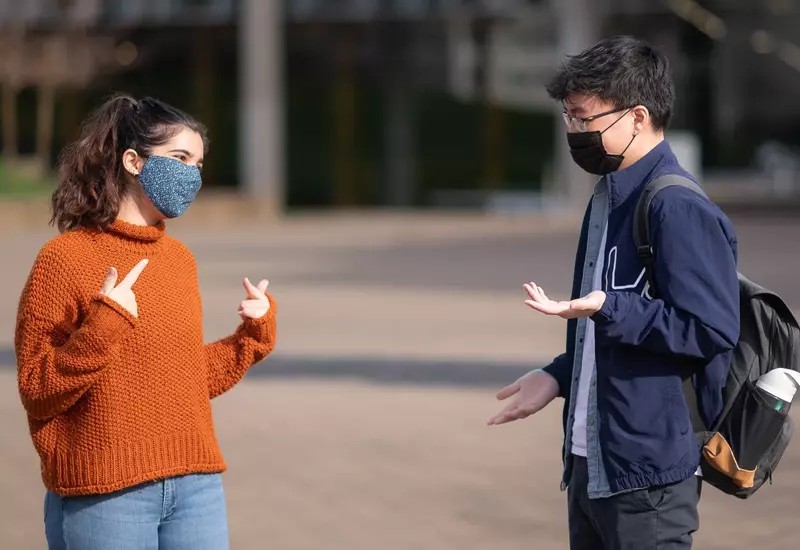

According to a new study carried out by researchers from the Indian Institute of Science (IISc) along with collaborators from the Nordic Institute for Theoretical Physics (NORDITA) in Stockholm and the International Centre for Theoretical Sciences (ICTS) in Bengaluru, the risk of COVID-19 can be reduced considerably if people while talking just turn their heads away by nine degrees from each other while still maintaining eye contact.(Photo for representation)
<p>
The risk of COVID-19 can be reduced considerably if people while talking just turn their heads away by nine degrees from each other while still maintaining eye contact, according to a new study.&nbsp;</p>
<p>
The study carried out by researchers from the Indian Institute of Science (IISc) along with collaborators from the Nordic Institute for Theoretical Physics (NORDITA) in Stockholm and the International Centre for Theoretical Sciences (ICTS) in Bengaluru, has been published in the journal<a href="https://www.cambridge.org/core/journals/flow/article/virus-transmission-by-aerosol-transport-during-short-conversations/2F7E421D937DBE4ACD08E2C09E4D1F2A" rel="nofollow"> Flow</a>.</p>
<p>
When a person sneezes or coughs, they can potentially transmit droplets carrying viruses like SARS-CoV-2 to others in their vicinity. Does talking to an infected person also carry an increased risk of infection? How do speech droplets or &ldquo;aerosols&rdquo; move in the air space between the people interacting?</p>
<p>
To answer these questions, a research team has carried out computer simulations to analyse the movement of the speech aerosols.</p>
<p>
The team visualised scenarios in which two maskless people are standing two, four or six feet apart and talking to each other for about a minute, and then estimated the rate and extent of spread of the speech aerosols from one to another.</p>
<p>
The simulations showed when the speakers were of drastically different heights (one tall and another short), the risk of infection was found to be much lower than when the height difference was moderate.</p>
<p>
Based on their results, the team suggests that just turning their heads away by about nine degrees from each other while still maintaining eye contact can reduce the risk for the speakers considerably.</p>
<p>
Their simulations also showed that the risk of getting infected was higher when one person acted as a passive listener and didn&rsquo;t engage in a two-way conversation. Factors like the height difference between the people talking and the quantity of aerosols released from their mouths also appear to play an important role in viral transmission.</p>
<p>
&ldquo;Speaking is a complex activity &hellip; and when people speak, they&rsquo;re not really conscious of whether this can constitute a means of virus transmission,&rdquo; says Sourabh Diwan, Assistant Professor at IISc and one of the authors of the study.</p>
<p>
In the early days of the COVID-19 pandemic, experts believed that the virus mostly spread symptomatically through coughing or sneezing. Soon, it became clear that asymptomatic transmission also leads to the spread of COVID-19. However, very few studies have looked at aerosol transport by speech as a possible mode of asymptomatic transmission, according to Diwan.</p>
<p>
<strong>Also read:<a href="https://www.indianarrative.com/health-news/india-s-daily-count-of-fresh-covid-cases-jumps-mumbai-delhi-see-highest-surge-177781.html"> India&rsquo;s daily count of fresh Covid-19 cases jumps 38.4%, Mumbai &amp; Delhi see highest surge</a></strong></p>
Prime Minister Narendra Modi arrived in Maldives on Friday as a part of his second…
The reduction in import duties on automobiles under the newly signed India-UK Free Trade Agreement…
Prime Minister Narendra Modi and his UK counterpart Keir Starmer shared a light moment during…
Prime Minister Narendra Modi lauded the signing of the landmark India-UK Free Trade Agreement on…
United Kingdom Prime Minister Keir Starmer on Thursday said that the UK-India FTA is the…
A Visiting Indian medical team on Thursday began treatment of patients injured in a fighter…